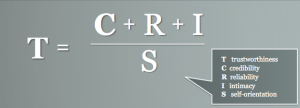The Twin Sins of Trust
You’ve probably heard “sins of commission, and sins of omission.” It is usually linked to Christian theology, particularly some of the New Testament gospels and Paul’s epistles , but it also has been used by writers like Moliere, and in discussions of Aristotle.
Anyway, it’s a simple enough idea to be broadly useful. A “sin of commission” is doing the wrong thing. A “sin of omission” is a failure to do the right thing.
Sins of commission tend to be more obvious by their nature – but sins of omission can be catastrophic. Think of a lifeguard failing to respond to someone who “sort of” looks like they are in distress. Think of the “good German” concept (failure to act against the Nazis).
But especially, think of the two concepts as they relate to trust.
The Drivers of Commission and Omission
The nature of trust is that it involves risk. If risk is not present, then we may be talking about probabilities, but we’re not talking about trust. Someone must take a risk for trust to arise.
The risk almost always consists in potentially committing a sin of commission. I answer a question you have; I observe something about you or your business; I tell you what I think you need to do, or I hold forth on some topic. In all those cases – I could be wrong. That is the risk.
Taking that risk opens me to a sin of commission. I might be wrong. You might be offended. I might not get the sale. Everyone might suddenly realize that I’m the blundering fool I’ve desperately been trying to keep hidden from people. And so, we do nothing, because it feels less risky. And in this we are wrong.
But by doing nothing, we open ourselves to the possibility of sins of omission. If I take no pain, I get no gain. Nothing ventured, nothing gained. Wayne Gretzky said, “You’ll never miss a shot you never take.”
And the results are measured in lost opportunity. Love. Repeat business. Deeper, trust-based relationships.
The Calculus of Commission and Omission
Here’s the thing. People systematically over-estimate near-term results and underestimate long-term results; and they over-estimate the pain of commission vs. the pain of omission. We fear losing something more than we fear not gaining something. One bird in the hand is worth two birds in the bush (i.e. 50% more valuable).
The result? A systemic bias to absorb sins of omission, rather than suffer sins of commission. Applied to trust, that means the most likely reason for low trust is the failure to take a risk in the first place. And I see this every day, all around me.
I see it in technical and services professionals. They fear being wrong more than they fear appearing silent, and so they say nothing, or they blather on about the unimportant. They are so fearful of emotional connection that they attribute that same fear to the customers, telling themselves that customers really don’t want relationships, that they must remain “professional.” In this, they are painfully, systematically wrong.
I see it in relationships. People are afraid of being vulnerable or hurt, so they shut down, or they pre-emptively attack others.
I see it especially in sales. The fear of doing something wrong leads salespeople to do what they think is low-risk. That usually means sticking with credentials, filling in silences, talking about themselves, or “How ’bout them Bulls.” God forbid they have to answer a question to which they don’t know the answer, or engage the customer emotionally.
Institutional Trust
And then there is structural trust. The more we try to improve institutional trust by guarding against sins of commission, the more opportunity costs of trust we create. When we pass legislation to prevent abuses of trust, when we insist on more insurance clauses in our contracts, and when we build more steps into our business processes, we are chipping away at trust by failing to allow any risk at all. This is why business so easily confuses compliance with trust.
The moral of the story is this: if you strip out all risk, you end up with no trust. And that is not a happy world to live in.



 Sometimes I get annoyed. Usually, that means I’m thinking like an idiot. Sometimes, however, it produces useful ideas.
Sometimes I get annoyed. Usually, that means I’m thinking like an idiot. Sometimes, however, it produces useful ideas. “Intimacy” belongs in business. Yes, intimacy. Not the kind that was the subject of classic ‘40s movies, but the kind that is essential to building trust.
“Intimacy” belongs in business. Yes, intimacy. Not the kind that was the subject of classic ‘40s movies, but the kind that is essential to building trust.